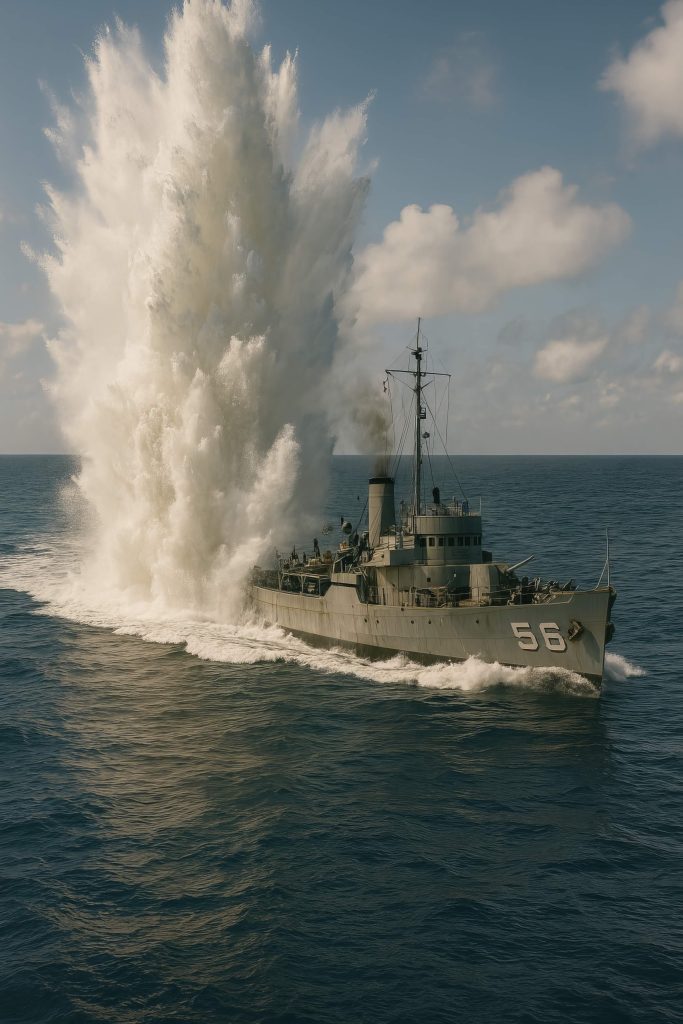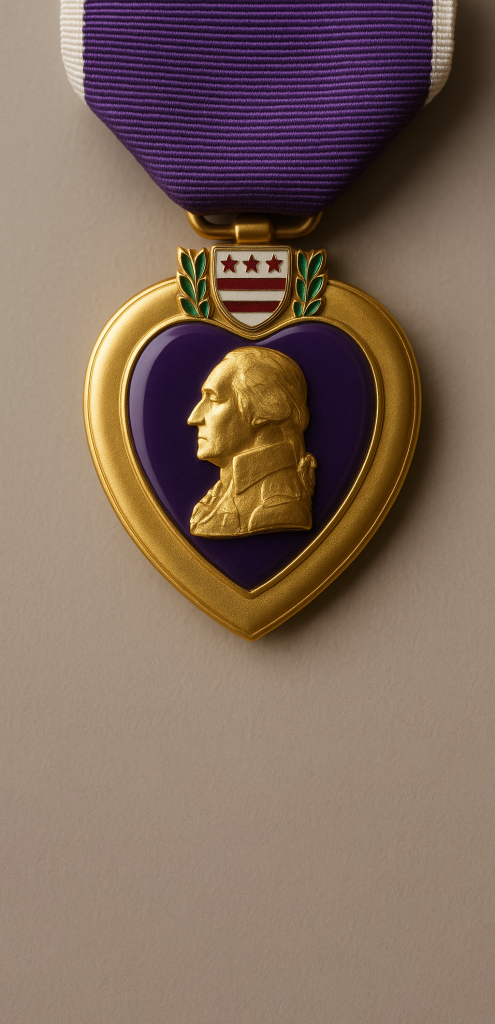The Purple Hearts journey-from the birth of a nation to the depths of the Atlantic-reminds us what freedom truly costs.
by Gary Wade
Appeared in Cityview Magazine, Vol. 41, Issue 6 (Nov/Dec 2025)
In 1782, near the end of the Revolutionary War, George Washington, as commander-in-chief of the Continental Army, awarded what he named the Badge of Military Merit to three of his officers. This simple purple ribbon became the forerunner of what became the Purple Heart. Over 150 years later, the medal was redesigned. The heart-shaped, one-and-three-eighths-inch brass alloy is purple and gold, bearing a profile of Washington on the front. “For Military Merit” is inscribed on the back.
For a limited period of time during the Second World War, The Purple Heart was awarded to those not only wounded in action but also those exemplifying meritorious service. When Congress established The Legion of Merit, however, President Franklin Roosevelt and the War Department determined that The Purple Heart medal would only be for members of “the US Armed Services who, while serving under competent authority after April 5, 1917, has been wounded [or] killed … in any action against an enemy of the United States.” Because The Purple Heart extends to any branch of the military, in World War II alone over one million individuals qualified for the award. In the foreign wars since, more than five hundred thousand more members of the military have been honored with the sacred medal – a fitting tribute for service under fire but one every soldier would prefer to avoid.

One of the more prominent individuals granted the award was John Fitzgerald Kennedy, who was in command of a PT-109 patrolling waters near the Solomon Islands in the Pacific Ocean. In the complete darkness of the early morning hours of August 2, 1942, a Japanese destroyer rammed the 80-foot vessel, slicing it in two and igniting its engines. Two of the 13 crew members were killed instantly. Many were severely burned. Lieutenant Kennedy suffered back injuries which plagued him for the rest of his life. As the pieces of the patrol boat sank, life jackets kept the 11 survivors afloat. Over the next five hours, the men were ultimately able to make their way to the shore of one of the remote islands. Kennedy was able to tow “Pappy” McMahon, the most seriously wounded, by clinching his teeth to a strap from McMahon’s vest and slowly swimming the three miles to land. A day later, Kennedy carved a message on a coconut, “11 alive, need a small boat,” and handed it to two of the natives of a nearby island. In a stroke of good fortune, the message made its way to a New Zealand infantry patrol, who soon came to the aid of the survivors. Sadly, the Purple Heart awarded John Kennedy for his injury was not to be the family’s last. A year later, his older brother Joe Kennedy, Jr., died when his Navy airplane exploded in a combat mission over Europe. To date, the only United States president to receive The Purple Heart is JFK.
Closer to home is the story of Tennessee’s James Oliver Cunningham of the USS Eagle 56, one of 60 patrol boats built by Henry Ford during World War I and designed to chase and destroy German submarines. Never placed in service during the Great War because of difficulties in maneuverability, only eight of these were utilized in the Second World War. On April 23, 1945, only 15 days before Victory in Europe Day, Eagle 56 was lost off the coast of Maine. Of the 62-man crew, only 13 survived. Cunningham did not make it. At a hearing before a Naval Board of Inquiry, five of the 13 survivors testified that they had seen a red and yellow emblem on the sail of an enemy submarine at the time of the explosion. Nevertheless, the Board classified the loss due to an explosion of a boiler. The Rear Admiral who reviewed the Board’s findings, later wrote, “at least equal evidence [tends] to support the conclusion that the explosion was that of a device outside the ship, the exact nature of which is undetermined. It might have been an enemy mine or an enemy torpedo.” Despite this observation, the admiral upheld the Board’s determination. In consequence, none of the sailors qualified for The Purple Heart.

Some 75 years later, the wreckage of Eagle 56 was discovered in frigid waters five miles off the coast of Maine. A civilian dive team featured in a recent Smithsonian Channel documentary made a video of the sunken vessel at its depth of approximately 300 feet. Its boilers were fully intact, confirming that was not the source of the explosion. Moreover, the release of a classified report more than a half-century after the wreck established that the Navy had information that German submarine U-853 had been operating outside of nearby Rhode Island during the spring of 1945 and, further, had sunk a bulk cargo ship shortly after the Eagle 56 disaster. The classified report indicated that on May 6, 1945, 13 days after the loss of Eagle 56, Navy and Coast Guard ships had found and destroyed the U-853 submarine. Its markings of a red horse and a yellow shield corroborated with the testimony of the five witnesses at the Board of Inquiry that had taken place so many years before. To its credit, the Naval Historical Center in 2001 had concluded the sinking of Eagle 56 was actually a combat loss. Purple Hearts were, therefore, awarded to the three survivors then living and the families of those, like Cunningham, who had either lost their lives in the explosion or had died before the re-classification.
In Morristown in August of 2019, Cunningham’s sister, Clara Cunningham Osborne, was honored in a ceremony conducted by then First Congressional District Representative Phil Roe, Mayor Gary Chesney, Jack and Mike Fishman of the Citizen Tribune, and other community leaders. Described as a “pillar of their community,” she accepted The Purple Heart tragically earned by her older brother. Osborne, only 11 years old at the time of her older brother’s death, recalled that upon his graduation from high school, he had fulfilled a lifetime dream by joining the Navy. She remembered that during his tenure of service, he sent money to his parents, who lived near Jackson, Tennessee, at the time, so that they could buy him a home there. During a short furlough from active duty and just prior to his death, James Oliver Cunningham was able to tour the home he would never be able to occupy. God only knows “what might have been” for all of those, like James, who gave their lives for The Purple Heart.

Comments are closed.